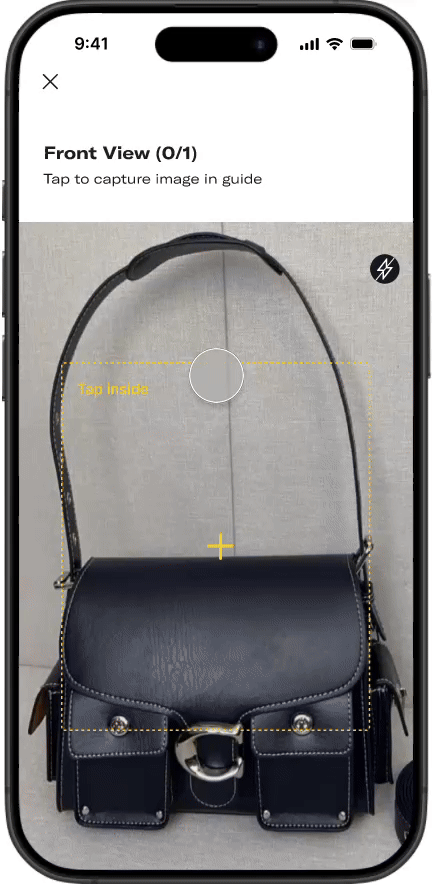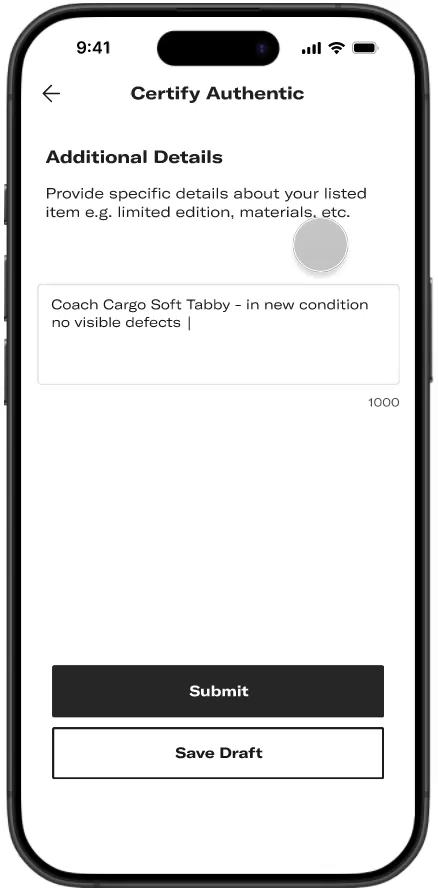Depop Certify Authentic
Role
UX Designer, UX Researcher
User Interviews, Surveys, Competitive Analysis, Wireframing, Prototyping
Methods
Implement a comprehensive authentication feature on Depop to ensure a secure and reliable user experience.
DesignLab Project
Scope
3 weeks (October 2024-November 2024)
BACKGROUND
Depop: Revolutionizing Secondhand Shopping
Depop is a secondhand selling platform with approximately ~35 million users who can sell their used clothing and other items for others to purchase, bringing in 35 million in revenue. Their goal is to continue to extend the life of items and promote buying secondhand.
Problem
Depop does not provide an authentication process for sellers to verify that their item listings are authentic, creating distrust and hesitation from potential buyers.
Solution
Authenticating luxury and vintage items with ease with Depop’s Certify Authentic to certify listings that fall under the luxury/vintage category.
First-time vintage and luxury buyers and seasoned buyers can feel confident in their purchase, knowing that listed items have undergone a thorough authentication process.
SOLUTION
Step-by-Step Guide
STEP 01
Users can capture live images of their items for authentication, ensuring real-time verification and preventing the use of fake images.
STEP 02
Live Image Capture
Users can capture live images of their items for authentication, ensuring real-time verification and preventing the use of fake images.
Users can upload proof of purchase or existing item certifications for enhanced security.
Add a Receipt
STEP 03
STEP 04
Additional Details
Users can provide detailed information about their items, highlighting key identifying features of their luxury or vintage pieces.

Empathize
What Users Love (and Struggle With) on Second-Hand Platforms
USER SURVEY RESULTS
To gain a clearer understanding of the second-hand platforms most popular with current users, I conducted a survey to explore the platforms they frequent, the items they buy and sell, and the challenges they currently face. A total of 11 participants, ranging in age from 18 to 54, completed the survey, all identifying as secondhand buyers and sellers.
The most popular second-hand shopping platforms among participants, ranked by frequency of use, were eBay, Depop, Poshmark, and Mercari. Here are the key insights gathered from participant responses:
Struggles
Trusting sellers, scams (fake items), and seller fees.
Sellers' Process
Taking quality images, writing detailed descriptions, sorting items, and pricing fairly.
Popular Items Ranked
Clothing, Vintage & Collectibles, Accessories, Footwear, Home Goods, Electronics, Books & Media
Shopping Frequency
Majority Weekly (9) Daily (1) Once a year (1)
Item Search
Using keywords (e.g. Mermaid core, Fairy core), specific descriptions, and brand names.
Leveling Up Depop: Competitor Insights
COMPETITIVE ANALYSIS
I conducted preliminary research on other leading second-hand shopping platforms within the same competitive space as Depop, aiming to identify their strengths and weaknesses. By comparing their current features, I analyzed how these elements contribute to enhancing the user experience.
A few notable differences across platforms included the absence of features such as item authentication (for luxury items), local pick-ups, and image search. Both Poshmark and eBay, however, provided item authentication for luxury items, offering buyers added assurance when making these purchases. This led me to consider how introducing an authentication process on Depop could enhance the platform by fostering greater trust among its users.
Real Talk: Depop Users Share Their Thoughts
USER INTERVIEWS
I began recruiting participants with experience using Depop, specifically those who identified as either buyers or sellers. I selected 5 participants aged 18+, including 4 who were both buyers and sellers, and 1 who was exclusively a buyer. All participants confirmed that they used the platform regularly.
The interview was designed to explore their experience on Depop and gain insights into their listing and purchasing processes as both sellers and buyers. These interviews were designed to identify current issues on the platform, helping to inform which features should be added to improve the user experience.
During the interviews, participants highlighted trust as a crucial factor when purchasing second-hand items. They want to feel confident that the item they’re buying matches the seller's listing. Key factors influencing their decision to buy from a seller included high-quality images, reviews, accurate descriptions, and clear communication.
When it comes to purchasing luxury or vintage items, the stakes are higher, as buyers are at greater risk of receiving inauthentic or counterfeit items. While some participants had a solid understanding of the key questions to ask before purchasing these items, they still acknowledged the ongoing issue of counterfeit and inaccurate listings.
Depop Deep Dive: What Sellers and Buyers Want

Define
Marissa The Creator
USER PERSONA
Using feedback from user interviews in the research phase, the following persona was developed to capture the users' needs.
Marissa The Creator: A college student and avid thrifter who would like to begin purchasing secondhand luxury items but does not feel confident she has the information she needs to find authentic listings.

Ideate
Navigating through Depop’s Certify Authentic
IDEATE
The following user stories were developed based on insights from user interviews, highlighting existing concerns using Depop and identifying ways to address them.
01
"As a buyer, I want to ensure that item listings are authentic and accurate."
02
"As a buyer, I want to feel secure and confident when purchasing vintage or luxury items."
03
"As a seller, I want to build trust with potential buyers by ensuring they know the items I sell are authentic."
User Flows
Keeping these user stories in mind, I created two potential user flows to map out the authentication process: one from the seller's perspective when uploading a vintage or luxury item, and one from the buyer's perspective when purchasing.
Flow #1: Purchase vintage/luxury item from a seller
Flow #2: Create a listing for vintage/luxury item

Wireframes
Low Fidelity Wireframes
I chose to start by sketching the steps from the seller's point of view. I sketched several potential screens to brainstorm the user authentication process, ultimately selecting a few to develop into mid-fidelity prototypes that addressed feedback from previous user interviews.
DESIGN
Mid Fidelity Wireframes
After sketching the initial low-fidelity screens, I progressed to designing mid-fidelity frames that outlined each step of the authentication process. The key screens included the following:
Authentication Guide →A step-by-step summary of the authentication process, providing users with a clear reference before they begin.
Live Image Capture →A screen where users capture images of their item from required angles, ensuring authenticity by preventing the use of fraudulent images.
Add Receipts →An option for users to upload proof of purchase along with any existing certifications for the item.
Additional Details →A prompt encouraging users to provide extra information, highlighting key identifiers to confirm the item’s authenticity and offering essential details for buyers.

Usability Testing
Users Weigh in on Authentication Process
MIDFIDELITY TESTING
I tested my initial mid-fidelity prototype through an unmoderated session, where 4 participants aged 18+ completed the task of authenticating an item for listing on their profile. All 4 participants successfully completed the task, highlighting that the process was intuitive and straightforward.
After testing, participants were asked to rate the difficulty of completing the task on a scale of 1-5, with an average rating of ~2 (not difficult). When asked if they would use the authentication feature, all 4 participants agreed that the process would be valuable for both sellers and buyers. The only suggestion came from one user, who recommended making the 'Start' button fixed so users wouldn't need to scroll to the bottom of the page.
HI-FIDELITY TESTING
What Users Are Saying
After making minor adjustments based on feedback from the mid-fidelity testing, I began recruiting participants for hi-fidelity testing. I recruited 5 participants aged 18+ who had experience using Depop as both buyers and sellers. All 5 participants successfully completed the task, rating the difficulty level with an average of 1 out of 5 (not difficult at all). Participants felt the process would be valuable for both buyers and sellers when purchasing luxury or vintage items.
During testing, two users mentioned that they were initially unclear on the meaning of "authenticate." However, after completing the process, they felt more confident in their understanding and suggested using a clearer term to improve user comprehension. Another user expressed uncertainty about where to tap at first and recommended emphasizing the action more clearly, not just within the description.
HI-FIDELITY REVISIONS
User-Driven Tweaks
During the hi-fidelity testing session, users provided feedback on potential changes to improve the final product feature. The following updates were made:
‘Authenticate’ to ‘Certify Authentic’ → Two users found the term 'authentication' confusing, suggesting 'certify' was more familiar. As a result, the label was changed to 'Certify Authentic.'
Text Guide→ One user was unsure where to tap to capture the live image, so a text guide was added to clarify the image capture process.
From ‘Authenticate' to 'Certify Authentic'
SOLUTION 01
To eliminate confusion among users unfamiliar with the term "Authenticate," it was renamed to "Certify Authentic."
Adding Text Guidance for Tapping Accuracy
SOLUTION 02
Adding text instructions to guide users on where to tap, based on feedback from previous testing, to prevent accidental taps on other areas of the screen.

Branding
VISUAL STYLE GUIDE
Staying On-Brand
To ensure the new feature seamlessly integrated into Depop's ecosystem, I adhered closely to their branding guidelines in the absence of a UI kit. I utilized their media toolkit for logos and images and leveraged Developer Tools to inspect platform elements for accuracy.

Final
Prototype
My Takeaways
Designing With Constraints
One of the main challenges I encountered during this project was working within an existing design system, which imposed constraints and limited my ability to deviate from the established guidelines. This experience has taught me the importance of working within established design systems to ensure consistency throughout the design process. Deviating from existing patterns can confuse users who have specific expectations when interacting with the platform. Working within the design system pushed me to innovate within the constraints, ensuring I developed a solution that would enhance the user experience.
Next Steps
AI Integration
Due to time constraints, I wasn’t able to fully implement AI integration in the authentication process. The intended design included an AI assistant that would guide users through listing their items by providing tailored prompts outlining the key details needed for accurate authentication. This would help bridge the knowledge gap for first-time buyers and sellers who may not be familiar with the subtle distinctions between authentic vintage items and counterfeits. With more time I would run an additional round of testing for this feature for accurate authentication to reduce errors and ensure consistency in the process.























